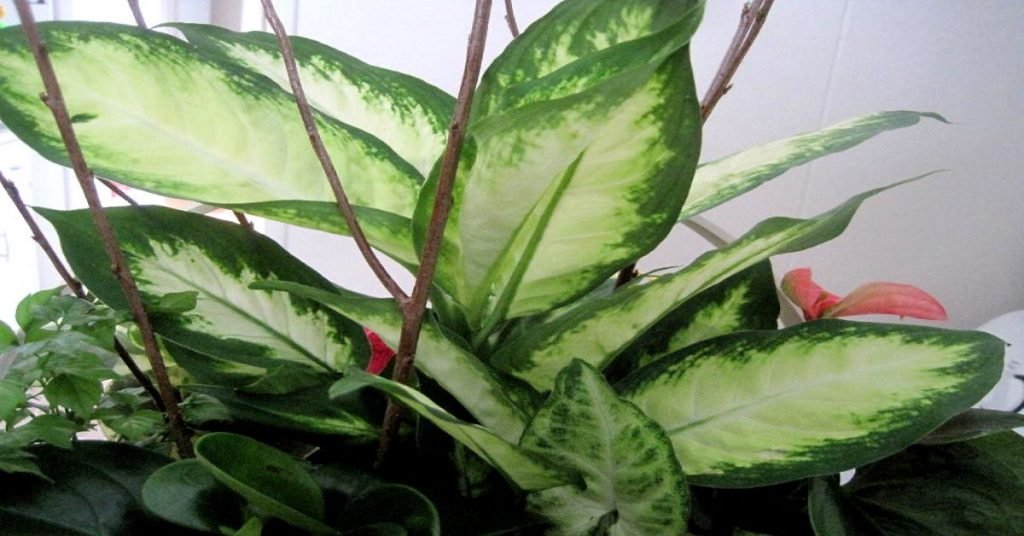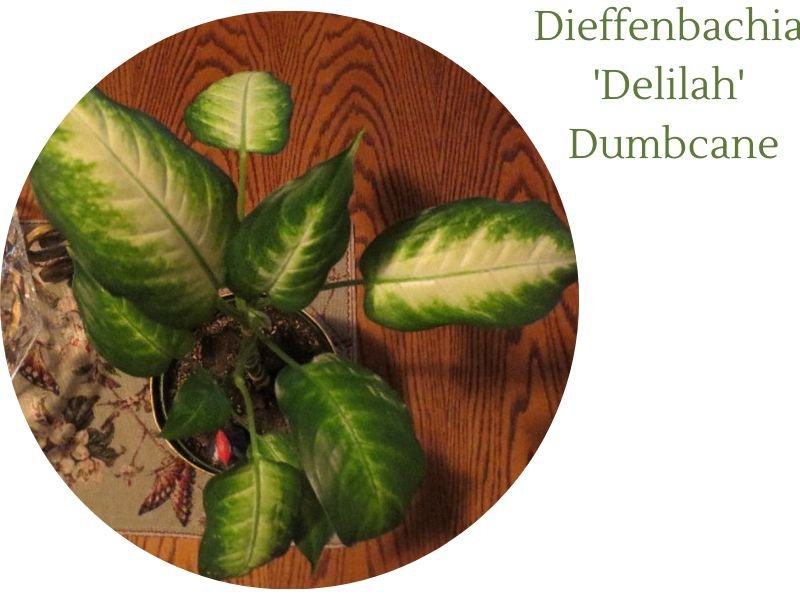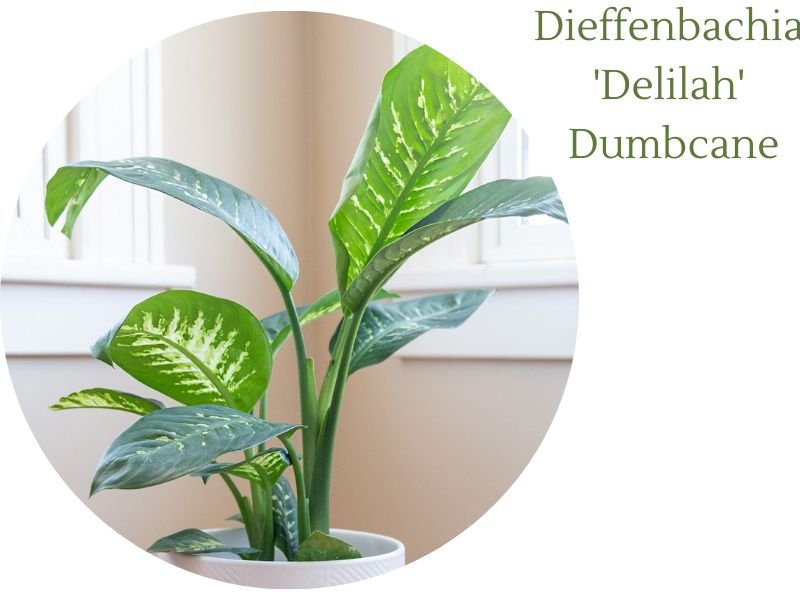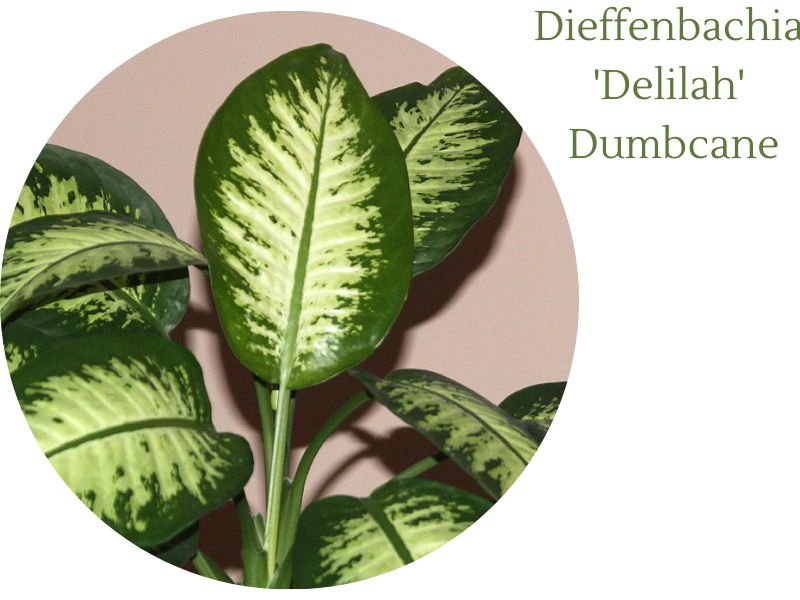Table of Contents
Brief overview of Dieffenbachia Delilah Dumbcane
The Dieffenbachia Delilah Dumbcane is one of the most captivating indoor plants you can have in your home or office. This plant is a tropical shrub native to South America and is famous for its striking foliage, featuring large green leaves with white or yellow variegation. The leaves grow in a rosette pattern, making it an excellent choice for those seeking to create a dramatic, eye-catching statement in their living space.

Unlike other houseplants that can only be found in specialized nurseries, the Dieffenbachia Delilah Dumbcane is widely available and can be purchased from various garden centers or online retailers at relatively affordable prices. This makes it an ideal choice for anyone looking to add some greenery to their interior decor without breaking the bank.
Importance and popularity of the plant
The popularity of Dieffenbachia Delilah Dumbcane has been on a steady rise over the years. Its lush foliage not only provides an elegant touch to your space but also comes with numerous health benefits. It has been proven by NASA scientists that these tropical plants are capable of purifying indoor air by removing toxins such as formaldehyde, benzene, and trichloroethylene.
Moreover, this houseplant requires little maintenance and can thrive well even in low-light conditions – making it an excellent option for novice plant owners who may not have enough experience caring for other plants. With its tropical vibe and easy care requirements, there’s no doubt that this plant has become an icon of modern indoor gardening culture – and rightly so!
Origin and Sign of warning!

Dieffenbachia plants, belonging to the Araceae family and Arum genus, are tropical plants commonly found in households. The main species are Dieffenbachia pincta and Dieffenbachia seguine (or Dumb cane). They are known by various names like ‘Giant Dumbcane,’ ‘Spotted Dumbcane,’ ‘Dumb Plant,’ ‘Tuftfoot,’ and ‘Mother-in-Law’s Tongue.’
The name ‘Dumb cane’ for Dieffenbachia plants is derived from their ability to cause temporary speech impairment. When the plant is chewed or the juice comes in contact with the mouth, it can lead to painful swelling and edema, making it difficult to speak. As a result, the plant acquired the name ‘Dumb cane’ due to its association with temporary loss of speech.
These plants contain calcium oxalate crystals and can cause edema of the mouth and oropharynx, leading to impaired speech. Chewing or even contact with the plant’s juice can result in painful swelling. Dieffenbachia has historical significance and was named after J. D. Dieffenbach, a German physician and botanist. It is native to tropical America and has been used by the Tucuna Indians in making arrow poison.
Physical Appearance and Characteristics
Dieffenbachia Delilah Dumbcane is a beautiful and easy-to-care-for houseplant that can add a touch of tropical beauty to any home or office. The plant is known for its lush, broad leaves that come in various shades of green and yellow. These leaves have an ovate shape with pointed tips, which can grow up to 18 inches long and 8 inches wide.
One of the most distinctive features of the Dieffenbachia Delilah Dumbcane is its stem. It has a thick, fleshy trunk that is covered in rough, scaly bark.
This trunk can grow up to six feet tall, making it an eye-catching addition to any room. The plant also produces small white flowers that are arranged in a spiky inflorescence.
Varieties and Cultivars Available in the Market
There are several varieties and cultivars of Dieffenbachia available in the market, each with its own unique characteristics and appeal. One popular variety is the Dieffenbachia Compacta, which has smaller leaves than other varieties but still maintains the same lush appearance.
Another variety is the Dieffenbachia Tiki, which has striking variegated green and yellow leaves. For those who want something more unique, there are also cultivars such as the Dieffenbachia Camille with its creamy white center or the Dieffenbachia Honeydew with its white-green variegated leaves.
Regardless of which variety or cultivar you choose, all dieffenbachias share similar care requirements including proper lighting conditions, watering needs, soil type preferences as well as temperature ranges for optimal growth. By choosing a variety or cultivar best suited for your environment you’ll unlock all this plant has to offer while adding beauty to your indoor space!
Benefits of Having Dieffenbachia Delilah Dumbcane in Your Home or Office

Air-purifying properties
In today’s world, with pollution levels rising at an alarming rate, clean air has become a luxury. The Dieffenbachia Delilah Dumbcane can be your ultimate savior. According to studies conducted by NASA in 1989, the plant is highly effective in removing air pollutants such as formaldehyde, benzene, and trichloroethylene from the air.
These chemicals are commonly present in household items such as furniture polish, cigarette smoke, and plastics. By having a Dieffenbachia Delilah Dumbcane plant in your home or office, you can breathe easy knowing that it’s filtering out harmful toxins from the air.
Aesthetic appeal
Aesthetically speaking, there’s no denying that these plants are a sight to behold! With its lush green leaves featuring prominent white stripes and speckles along the edges of each leaf when matured enough – they make for an excellent statement piece that adds natural beauty to any room. Whether it’s placed on a desk or on a shelf – it will undoubtedly brighten up any space with its vibrant foliage.
Not only do they add visual appeal but also contribute to creating a peaceful environment within which you can relax and unwind after a long day at work. At times when life gets overwhelming and stressful – having such greens around us can do wonders for our mental health.
Low maintenance requirements
yet importantly- let’s talk about how easy it is to maintain this plant! With minimalistic care needs – even those without any prior experience of gardening will find themselves succeeding with this species. They require low light intensity making them ideal indoor plants and need watering only once every week – depending on factors such as humidity and temperature.
Additionally, they don’t require any specialized pruning or shaping; their natural growth pattern is quite appealing to the eye. This makes it a perfect plant for someone who loves to have plants around them but can’t devote a lot of time to tending to them.
Also Read:
- The Best Indoor Plant Grow Lights for Thriving Houseplants
- Gardening Books: Essential Reads for Green Thumbs
- DIY Garden Projects: Creative Planting Ideas
- The Ultimate Guide to Organic Fertilizers for Healthy Plant Growth
- Must-Have Garden Insecticide for Pest Control Solutions
How to Care for Your Dieffenbachia Delilah Dumbcane Plant
Light Requirements: Indirect sunlight vs direct sunlight
One of the most important aspects of caring for your Dieffenbachia Delilah Dumbcane plant is ensuring it gets the right amount of light. This plant thrives in indirect sunlight, which means positioning it near a bright window or using a sheer curtain to filter out direct sunlight.
Direct sunlight can cause the leaves to burn and fade, so be careful not to expose your plant to too much sun. If you don’t have a suitable window or space in your home that offers indirect lighting, consider using artificial lighting options.
LED lights are an excellent choice as they emit minimal heat and are energy-efficient. Place them 6-12 inches above the plant and keep them on for around 12-16 hours per day.
Watering Needs: Frequency and amount of watering needed; Importance of proper drainage
Another crucial aspect of caring for your Dieffenbachia Delilah Dumbcane plant is getting the watering just right. These plants require moderate watering – enough to keep the soil moist but not waterlogged.
Watering once a week is typically sufficient, but monitor the soil’s moisture level regularly to ensure it stays consistent. Proper drainage is critical as waterlogged soil can cause root rot, which can be fatal for your plant.
Ensure that water drains adequately from the pot and avoid letting standing water accumulate at the bottom. Consider adding a layer of gravel or sand at the bottom of your pot before planting your Dieffenbachia Delilah Dumbcane – this will help improve drainage.
Soil Requirements: Type of soil needed for optimal growth; Fertilization needs
The type of soil you use when planting your Dieffenbachia Delilah Dumbcane plant is essential in ensuring it grows optimally. A well-draining potting mix that contains peat moss, perlite, or vermiculite should be used to keep the soil moist but not waterlogged.
Avoid using garden soil as it can be too dense and retain too much water. Fertilization is also important in maintaining your plant’s health and growth.
Use a balanced fertilizer during the growing season (spring-summer), diluted to half strength every two weeks. In the winter months, reduce fertilization to once a month as the plant will be in its dormant phase.
Temperature and Humidity Needs: Ideal temperature range for growth; Importance of humidity levels
Dieffenbachia Delilah Dumbcane plants thrive in warm temperatures between 65-80°F (18-26°C). Avoid exposing your plant to cold drafts or temperatures below 60°F (15°C) – this can stunt growth or cause leaf drop. Humidity levels are crucial for this tropical plant’s survival, so ensure that it is kept in an environment with moderate to high humidity levels between 40-60%.
You can help increase humidity by placing a tray of water near your plant or using a humidifier. Misting your plant regularly with distilled water can also help maintain proper moisture levels on its leaves.
Potential Problems with Dieffenbachia Delilah Dumbcane Plants

Common pests and diseases that affect the plant:
Dieffenbachia Delilah Dumbcane is generally a hardy plant, but like all plants, it’s susceptible to some pests and diseases. One of the most common problems is spider mites.
These tiny insects can cause severe damage to the leaves of your plant, including discoloration, webbing, and deformation. Other pests that may attack your Dieffenbachia Delilah Dumbcane include mealybugs and scale insects.
Disease-wise, the most common issue you’ll encounter with this plant is leaf spot or blight. This disease causes yellowing or browning of the leaves and can lead to leaf drop if not treated promptly.
Another problem is root rot which is caused by fungal infection in poorly drained soil. This disease causes roots to die back leading to wilting or yellowing leaves.
Tips on how to prevent:
Prevention is always better than cure when it comes to protecting your Dieffenbachia Delilah Dumbcane from pests and diseases. To prevent spider mites, try misting your plant regularly or wiping down the leaves with a damp cloth. Mealybugs are best dealt with using insecticidal soap which can be found in most garden centers or online garden shops.
In terms of blight prevention, make sure you’re watering your plant correctly – never let water sit in its container for too long as this leads to soggy soil which encourages fungus growth. Instead, opt for a well-draining soil mix that allows water to flow through.
Conclusion
Dieffenbachia Delilah Dumbcane is an excellent houseplant that will add natural beauty to any home or office. With proper care, this plant will flourish and provide benefits such as air purification and aesthetic appeal. Despite its hardiness, it’s vital to watch out for pests and diseases that threaten the health of your plant.
Thankfully, with preventative measures, most issues can be avoided altogether. So go ahead and add a Dieffenbachia Delilah Dumbcane to your collection – with a little care; you won’t be disappointed!

Gardening is my passion and growing plants indoors has always been a stress relief for me. Grow a banana tree in my apartment once (although failed to produce bananas).






